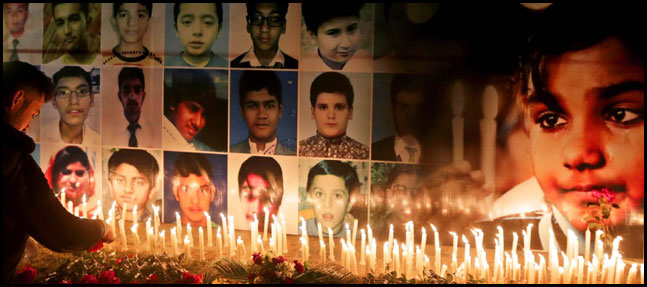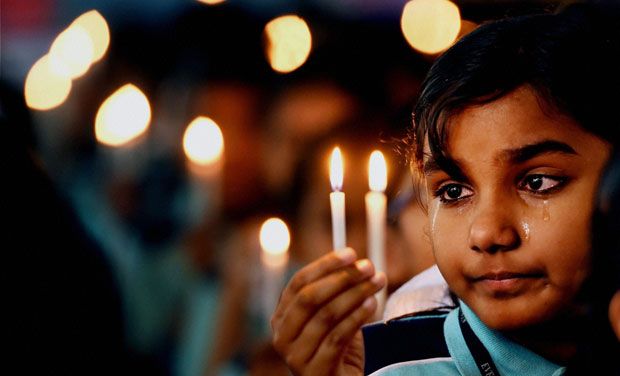Terror attacks were not something new for Pakistan. Right from the time Pakistan became a frontline state after the Soviet military occupation of Afghanistan in late December 1979, and began organizing resistance against the Soviet forces, there had been sporadic terror attacks in the country. These attacks were mainly in the form of bomb explosions, suspected to be the work of KHAD and KGB. In one such bomb blast in Karachi’s Saddar area in July 1987, 72 people were killed and more than 250 injured. Another wave of terror attacks came after Pakistan joined American sponsored “war on terror” in the aftermath of 9/11, in particular when Pakistan cooperated with the ISAF/NATO forces in a hammer and anvil operation towards the end of 2003 against the indigenous Taliban and Al-Qaeda militants who had taken refuge in Pakistan’s tribal belt. Then there was a terrible backlash in the form of multiple terror attacks after Lal Masjid Operation in mid-2007. Reportedly more than 150 extremists had been killed in the said operation and the terrorists wanted to take revenge from the Pakistan Armed Forces. In August 2008 and people. Twin suicide attacks killed 64 people outside the Wah Ordnance Factory near Islamabad.

But the response of the terrorists in the aftermath of the commencement of “Zarb-i-Azb” in the wake of attack on Jinnah International Airport Karachi was unbelievable. On 16 December 2014, a group of terrorists belonging to Tehrik-i-Taliban Pakistan, who were wearing uniform of Frontier Corps, entered the school and cold bloodedly slaughtered more than 141 students and teachers in the most heinous act of terrorism ever perpetrated in Pakistan. The details of what happened on that day are too ghastly to even recount. After indiscriminate firing in which scores of students were killed, some teachers were shot in front of their students. Many students were asked about their identity and then told to recite kalmia before they were martyred. The SSG commandos reached the venue as soon as the reports reached and in an operation rescued a large number of pupils. The reaction of the people over what happened was that of extreme anger and indignation. Although the people were used to receiving shocking news of terror attacks, this was unbelievable. No one ever thought that children could be made target of such cruelty and ruthlessness by any human being in the name of religion or made to pay a price for a conflict with which they had nothing to do. Their only fault was that they belonged to the families of the armed forces personnel.
These martyrs were like little angels whose starry eyes beamed with hope and ambitions for the future; whose hearts beat for Pakistan. As one looks at their innocent faces in photographs, one is overwhelmed with sorrow. Although a year has lapsed since the occurrence of the tragic event, one is unable to forget it. The families that lost their dear ones have not been able to overcome their pain and grief. For parents, the loss of their children is a life-long trauma. No words are appropriate to describe their sufferings. The loss is irreparable. Their courage in face of adversity and their resolution to stand against terrorism is commendable. One must appreciate the courage of the Principal and martyred teachers of the Army Public School who did not shirk from their duty. Who sacrificed their lives defending and protecting the students and pleading to the terrorists to inflict no harm on the innocent children who had nothing to do with what was happening around them. May the souls of martyrs of the Army Public School rest in peace. They laid down their lives in the path of Allah; they are not dead. As the Holy Quran says: “. . . . They are alive but you do not perceive how”. (Surah 2, al-Baqarah verse 154)

Mere expression of solidarity with the suffering families is not enough; although important in the sense that their pain is shared. Simultaneously with this, whatever is possible must be done to ensure that such tragedies do not occur in future. The Operation Zarb-i-Azb is one way of doing it. Director General of the Inter-Services Public Relations (ISPR) Lt. General Asim Bajwa has called the operation a ‘phenomenal success’ and stated that the last pockets of militants are being cleared near the Pak-Afghan border. According to him, “3,400 terrorists have been killed, 837 hideouts from where they operated have been destroyed.” The good thing about Operation Zarb-i-Azb is that as far as possible, the Army gets the targeted area vacated by the civilians before taking any action. Still there are chances of considerable ‘co-lateral’ damage taking place. The militants can exploit the spitting of innocent blood to spread hatred against the armed forces and to try to justify their targeting of the families of armed forces personnel. Since the beginning of Operation Zarb-i-Azb there is a visible decrease in terror incidents. The armed forces have maintained pressure on the Tehrik-e-Taliban Pakistan that had claimed responsibility for the massacre at the Army Public School, Peshawar. If the terrorists remain on run they would find it extremely difficult to plan and execute any terror attack.
In addition to military action, there is need to closely study the causes that lead to development of terrorist mentality and that too in the name of Islam. How come the religion of peace and justice is being projected as breeding terrorists? There is a tradition in Sahih Bukhari that in one of the Ghazwa which was conducted just before dawn, a companion of Holy Prophet (PBUH) slew a boy by mistake due to darkness. The companion was made to appear before the Holy Prophet (PBUH) and account for his act. And here are terrorists who have been brainwashed to believe that their acts are justified in Islam. Although four of the terrorists who were responsible for the Army Public School tragedy have been hanged, there is no guarantee that the terror attacks would not occur in future. Schools are particularly soft and easy targets for the terrorists. The state does not have resources to offer security and protection to all educational institutions. The nation as a whole would have to remain alert at every moment. Each Pakistani would have to remain watchful like Aitzaz Hasan, a boy from Hangu who sacrificed his life to prevent a suicide bomber from entering his school where nearly 2000 students were enrolled. To make the memory of Army Public School martyrs immortal and a beaconing light for coming generations, one would suggest building of a monument and constitution of scholarships for outstanding performance in schools. December 16 and the Shuhada and Ghazi of Army Public School Peshawar are memories those are engraved in our National Grief for all times to come. Long Live Pakistan Army, People and the Martyrs of APS Peshawar.